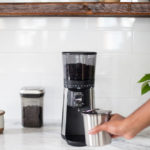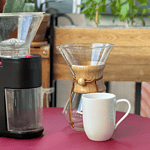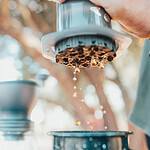Affiliate disclosure: We are reader-supported. This means that we may earn a commission if you buy an item using one of the links. For our reviews, we purchase products ourselves and review them independently. Read more about our methodology.
Summary of Differences
If you’re looking to purchase a coffee grinder, get a burr grinder. While burr grinders are more expensive than blade grinders, how they improve the taste of your brew justifies the additional expense. Burr grinders produce more consistently sized coffee grounds than blade grinders. This has a significant impact on improving the taste of the coffee you brew.
Even if you don’t have a high-end coffee maker or espresso machine, it’s worth investing in a good burr grinder to make better-tasting coffee. For most at-home coffee drinkers, a conical burr grinder represents excellent value for the price point. If you want to step up your game even more, look into flat burr coffee grinders as they grind more consistently than a conical burr grinder.
What are the Differences?
If you’re new to making your coffee at home, you’ve probably heard about if you should use a burr grinder or a blade grinder. But before we get into which one we prefer, let’s talk about the differences between the two.
Both a burr grinder and a blade grinder grind coffee beans into coffee grounds. How they do this and the quality of your brew are different.
What is a Burr Grinder?
A burr grinder grinds coffee between two abrasive surfaces. The distance between these surfaces determines how coarse the grind is. If the burrs are farther apart, it will produce a coarse grind. If they are close together, it will produce a fine grind.
Many burr grinders are electric, but some are manual, powered by a hand crank. You can use burr grinders to grind other things besides coffee (though we don’t recommend using one for multiple purposes). Many salt and pepper mills are hand-powered burr grinders. Many spice grinders are also burr grinders.
Consistency
A burr grinder produces an exceptionally consistent grind as each ground or flake will be roughly the same size. This consistency is because the coffee beans are torn between two surfaces. A burr grinder also creates less heat friction because it moves slower than a blade grinder. The reduced speed helps preserves the oils and flavors of the coffee beans.
Price
Burr grinders are generally more expensive than blade grinders. However, there are many entry-level options under $100. High-end models will go for a few hundred dollars or more.
Flat vs. Conical Burr Grinder
Burr grinders come in two types: conical burr and flat burr. Conical burrs have an inner cone that spins inside of a bigger stationary cone to crush the coffee beans.
As the name implies, flat burrs crush coffee beans between two flat burrs with serrated teeth. Some differences exist between conical and flat burrs, but both will produce a uniform grind that yields a tasty brew.
| Flat burr | Conical burr |
|
|
A conical burr grinder grinds much slower than a flat burr grinder or a blade grinder. This low speed gives it a couple of advantages. First, the slower rotation means there’s less heat generated, so your coffee beans won’t get heated, helping to preserve the flavors and oils in the beans.
Second, conical burr grinders are usually quieter due to the slower rotation speed. Because the grounds have to travel down to exit the conical burr, it’s less likely that coffee grounds will get stuck inside the burr.
Flat burr grinders, on the other hand, will produce an even more consistent grind than a conical burr due to their design. This is because the flat burr crushes the beans between two flat surfaces. They are generally more expensive than a conical burr grinder for this reason.
As noted above, flat burr grinders rotate much faster than a conical burr grinder, so you’ll need to pay attention to the heat and temperature to ensure it’s not affecting your coffee beans. They will generally be louder than a conical burr grinder. High-end flat burr grinders may have built-in ventilation systems and sound-dampening mechanisms to reduce these issues.
Generally speaking, many burr grinders meant for at-home use have a conical burr. Flat burr grinders are more common in commercial settings like coffee shops or coffee roasters because of their exceptional consistency.
What is a Blade Grinder?
A blade coffee grinder is very similar to a blender or food processor. Most blade grinders have two blades that spin at high speed to break down coffee beans into grounds.
Consistency
Unlike a burr grinder, a blade grinder will not produce uniformly consistent coffee grounds. The beans can move around easily in the grinder. As the grinder keeps grinding, some pieces will get smaller and smaller while others will remain large or unground. As the blade keeps spinning, it can produce grounds that are as fine as dust and that can clog up some coffee makers and espresso machines.
If you must use a blade grinder, experts recommend only using it for drip coffee. Finally, your coffee beans will warm up in a blade grinder because it rotates much faster than a burr grinder. The higher speed can impact the flavor, making the coffee more bitter or flat.
Price
Blade grinders are cheaper than burr grinders. A mid-tier blade grinder will run you about $15 to $30. You can get a decent entry-level conical burr grinder for around $40 to $50. You can sometimes snag burr grinders on sale for less than this.
Which One Do We Prefer?
We only use a burr grinder at home (ours is a conical burr grinder). We believe that the consistency of the grounds produced by a burr grinder justifies the price. You don’t need to buy an expensive burr grinder because an entry-level burr grinder will give you better coffee grounds than a blade grinder.
As for which burr grinder we use, we’ve had a Bodum Bistro Electric Burr Grinder for the past few years. There are a few improvements that Bodum could make to the design and the grinder. There are some consistency issues with coarse grinds and clumping issues with medium and fine grinds.
Our model retails for around $65, but Bodum makes a higher-end model priced at $131 ($143 at Amazon). The higher-end model has much better reviews on Amazon than our model. If you can swing it, we would recommend that model over the cheaper one. Both models go on sale frequently for up to 50% off the full price.
Other brands that make high-quality burr grinders include Baratza, Fellow, Ode, Timemore, Eureka, OXO, Breville, and others.


